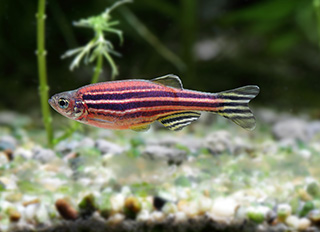The Use of CRISPR on Zebrafish Could Speed Human Gene Function Discovery
The gene editing technology, CRISPR/Cas9, is six times more effective than other techniques at targeting specific DNA sequences in zebrafish, according to a new study from the National Human Genome Research Institute (NHGRI) and published in Genome Research. This discovery, which also demonstrated that the CRISPR/Cas9 method can be used to target and mutate multiple genes at the same time, could speed the discovery of gene function and the identification of disease genes in humans.
CRISPR stands for “clustered, regularly interspaced, short palindromic repeat” and refers to a repeating pattern of DNA sequences that appear regularly in bacterial DNA, according to the NIH. The Cas9 protein is a nuclease, an enzyme that can be used to cut out a specific piece of DNA from a longer strand. CRISPR/Cas9, which was first described in 2012, work together as a tool that allows researchers to specifically target and delete or insert pieces of DNA ito animal-model embryos, in this case, zebrafish.
Zebrafish are well suited to large scale gene editing becauswe they share many of their genes with humans and are have a low cost of maintenance. “The key to zebrafish as a valuable model system is the depth of detail we have on the zebrafish genome. Because of a high quality zebrafish genome project, we know the zebrafish genome has roughly a 70% match with the human genome in terms of having precise gene to gene correlations, and the gene models are good enough to target effectively.,” Dr. Shawn Burgess, a senior investigator with NHGRI’s Translational and Functional Genomics Branch and head of the Developmental Genomics Section, told ALNexclusively.
In the study, the researchers targeted 162 genomic loci in zebrafish. When the offspring of these fish were screened with fluorescent PCR and high-throughput DNA sequencing, the researchers determined that mutations were passed to the new generation in 28% of cases. In some cases, the transmission rate was higher for some genes, but overall, the researchers found that screening offspring from parent fish should be enough to pinpoint most mutations.
These results show that the use of the CRISPR/Cas9 technique in zebrafish makes it possible to generate mutants for all genes in the zebrafish genome and carry out large-scale phenotyping.
The use of CRISPR/Cas9 could provide a faster way to discover gene function and the identification of disease genes in humans. “Human genetics is going through an explosion in terms of the data being generated. GWAS, QTL, and Exome sequencing have identified more disease candidate genes in the last 10 years than had collectively been identified in all the years before,” Dr. Burgess concluded. “However all this data is correlative and doesn’t prove the genes actually cause the phenotypes or diseases of interest. We need new and faster ways to validate all these candidate genes. Mouse gene knockouts are the traditional model for validating human disease candidate genes, but the costs are high and the speed is slow for mice in relation to the scale of the problem now. Zebrafish can cut costs and accelerate the validation rates by high throughput approaches like we have developed and published in Genome Research.”
The scientists plan on continuing their research with the CRISPR/Cas9 method to target genes that cause deafness in zebrafish in hopes to further understanding of hearing loss in humans.
http://www.alnmag.com/news/2015/06/use-crispr-cas9-zebrafish-could-speed-human-gene-function-discovery

